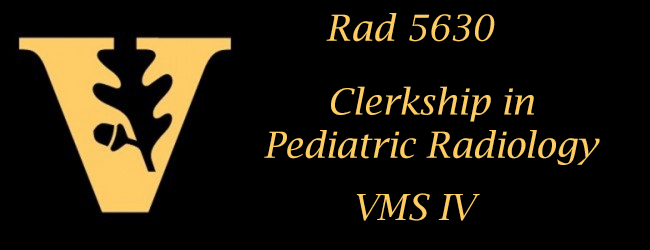
Our four week elective in pediatric radiology is a general radiology experience, as our common reading room interprets and manages all modalities, including radiography, fluoroscopy, ultrasound, nuclear medicine, CT, and MR of multiple body systems. Our elective is appropriate for the student interested in radiology, pediatrics, and internal medicine/ pediatrics.
Goals for our rotation: Not necessarily to learn how to interpret studies, but more to realize the appropriate indications for studies and how to interact with radiologists. We will cover how to appropriately work up general pediatric common conditions, such as limp, intussusception, vomiting in neonate vs. child, failure to pass meconium, hip click, etc. Another goal for the rotation is how to best provide history and background information to the radiologist when requesting a study. Students can be helpful in looking up additional history and background information for cases we are trying to protocol and interpret.
Requirements of the elective:
1. Pre test. This is to be completed by the first day on the rotation. The purpose of the test is for education and monitoring how much a student learns. You will receive an email invitation with the link to the Red Cap test.
2. Post test. To be completed the last week of the rotation.
3. End of Rotation Survey. To be completed the last week of the rotation.
4. Image Gently Pledge. Please print out a completed certificate after taking the pledge. http://www.pedrad.org/associations/5364/ig/
5. Attendance at the surgery conference that have Radiology as a theme. We participate in many multidisciplinary conferences, and most are good, including weekly surgical conference, weekly pulmonary conference, monthly GI conference.
6. Scavenger hunt. This exercise is to enhance reading room sessions, and many of the items are “hardware items” used in imaging, and many are imaging findings. Prizes will be awarded at the end of each academic year to the medical student with the most items found.
Daily routine:
Morning reading room assignments:
The student will be scheduled on the different modalities on a weekly basis. The schedule can be tailored to the student’s specific interests.
Specific modalities:
- Plain films: have a first shot at a “peds out” before staffing with the attending. Search for scavenger hunt items. The scavenger hunt items are attached. The medical student who finds the most items will be awarded a prize at the end of the academic year.
- Fluoroscopy: go in on cases, UGI, enemas, and VCUGs to see how different the exams are for children of different ages. Perform a taste test of the different contrast agents. Learn about radiation safety.
- CT/MR and US: review the overnight cases, protocol the daily work, critique requests for protocols, learn basics of these modalities.
Additional learning opportunities for the second half of the day:
- Radiology noon teaching conferences. Many of them are pediatric specific.
- Teaching file: We have a hard copy of the teaching cases from the American College of Radiology (ACR)—the “green” teaching file-- located in the Heller classroom. Alternatively, the Cleveland Clinic has a website with a digital teaching file: https://www.cchs.net/onlinelearning/cometvs10/pedrad/default.htm
- Modules developed for this elective, including the lines and tubes module.
- Covering the material in two textbooks.
- Pediatric Imaging: the Fundamentals. Author: Lane Donnelly.
- Felsons Principles of Chest Roentgenology: A programmed text. Author: Lawrence R. Goodman.
